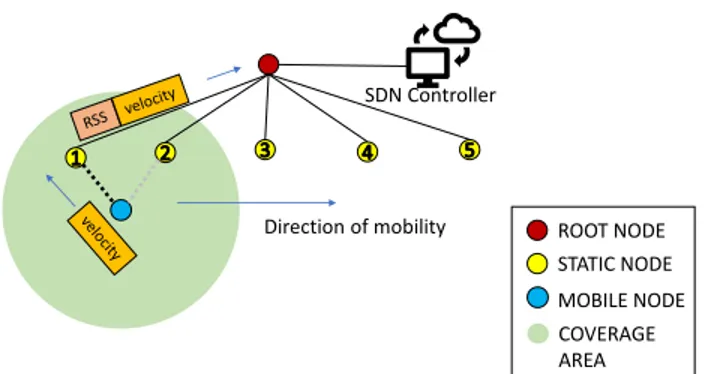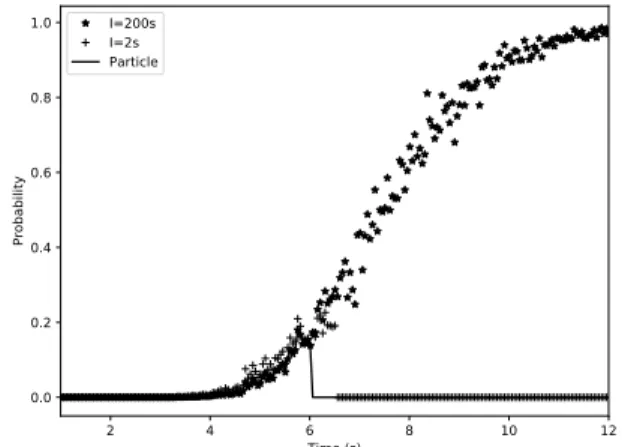Particle Filter for Handoff Prediction in SDN-based IoT Networks
Iliar Rabet, Shunmuga Priyan Selvaraju, Hossein Fotouhi, Maryam Vahabi, Mats Bj ¨orkman
School of Innovation, Design and Engineering, M ¨alardalen University, V ¨aster ˚as, SwedenAbstract
Standard implementation of RPL protocol has struggled to limit the impact of mobility on the throughput of the IoT network. Handoff process is of great importance to optimize the trade-off between the control overhead (for maintaining the network topology), and the delay, caused by nodes mo-bility. In this work, We have proposed a method for predict-ing future handoffs through fusion of RSSI value and Inertial Measurement Unit (IMU) information using particle filter, which is known for accuracy albeit it needs higher computa-tion capacity. The provided analytical model indicates lower network interruption with the proposed method.
Keywords
Particle Filter, SDN, Internet of Things, Handoff Process.
1
Introduction
Mobility is one of the major elements in future Inter-net of Things (IoT) applications, which requires proper de-sign of mobility solutions for IoT networks and protocols. Most of the IoT standards such as Routing Protocol for Low-Power and Lossy Networks (RPL) and 6LoWPAN assume that topological changes are negligible. Experiments have revealed that RPL experiences a degraded throughput in a mobile environment [8, 5, 6].
Smart-hop [8], mRPL [5] and mRPL+ [6] proposed hand-off processes with low communication overhead and low handoff delay for IoT networks. These handoff processes were designed in such a way to be independent of the mobile node movement information. This issue may cause hand-off performance degradation in networks, where the mobile node changes its mobility pattern. In some cases, it may also reduce network responsiveness to dynamic changes. Barcleo et. al. [1] have proposed Kalman Position-RPL (KP-RPL) in which, each mobile node is equipped with IMU sensors for sending positioning beacons regardless to velocity with a constant interval, and then they predict the future position based on Kalman filter. Similarly, EKF-MRPL [3] uses ex-tended Kalman filter to predict non-linear trajectory paths. In [9] authors utilize Doppler effect to estimate the velocity of the mobile nodes. This approach may fail to detect mobility in case there is no radio activity.
Direction of mobility ROOT NODE STATIC NODE MOBILE NODE COVERAGE AREA SDN Controller
Figure 1. As the mobile node moves the SDN controller updates the routes in the static and mobile node.
Particle filter, also known as sequential Monte Carlo [4], is a method used for non-linear filtering problems. Kalman filter is unable to provide good performance in scenarios with non-linear relation and non-Gaussian noise, and its varia-tions can handle such scenarios with low accuracy. In this work, we have designed a particle filter with higher accuracy due to the number of samples, that predicts the future Re-ceived Signal Strength Indicator (RSSI). Regarding the hard-ware constraints in IoT devices, most standards have been designed to avoid computation-heavy tasks in distributed nodes. With the rise of Fog computing, it is possible to of-fload the computation, as in MobiFog [7], which is a novel Fog-based approach designed for RPL routing. In this ap-proach, a centralised SDN controller manages the parent list of all nodes in the network, and provides a seamless handoff process with zero delay.
2
Prediction Framework
In many deployments, IMU sensors are used in applica-tion layer, and it is possible to make use of them in routing layer, or provide a cross layer approach. In our proposed method, when mobile nodes start moving, they broadcast their velocity to all static nodes in their vicinity in a spe-cific interval. Mobile node stops sending broadcasts as soon as it stops moving. However, in standard RPL, a mecha-nism called Trickle is used to determine the interval between the control messages to capture any change in the topol-ogy. Trickle algorithm gradually restores its interval after each change in the topology, but in our approach the interval restoration can be done instantaneously.
As shown in Figure 1, the intermediary nodes that can receive the broadcast packet including the velocity informa-tion, append the RSSI to the packet and forward it to the con-troller. The controller predicts the RSSI values in the next
PARTICLE FILTER INSTANCE #1 FOR MN1 PARTICLE FILTER INSTANCE #2 FOR MN2 PARTICLE FILTER INSTANCE #3 FOR MN3 [RSSI1t, RSSI2t, … ] [RSSI1t+1, RSSI2t+1, … ] [vx, vy] ROUTING MANAGER SDN CONTROLLER SDN messages
[RSSI1t+1, RSSI2t+1, … ] [RSSI1t+1, RSSI2t+1, … ]
[RSSI1t, RSSI2t, … ]
[RSSI1t, RSSI2t, … ]
[vx, vy]
[vx, vy]
Figure 2. The particle filter can have the current RSSI values and velocity of the mobile node as input and pre-dicts the future RSSI values at different static nodes. For each mobile node there can one specific instance of filter.
time slot and based on that, the routing manager decides to update the parent list using a SDN control packet.
As shown in Figure 2, we maintain the state information including both position and RSSI values from all static nodes that have received the broadcast message. The prediction step in the filter can use equation 1 to estimate future RSSI.
RSSID− RSSID0= −10α.log(
D0
D) (1)
3
Analytical Model
We devised an analytical model to compare performance of different behaviors of the system. There are also some research works that model the consistency of the standards [2]. However our model aims at comparing packet loss in a mobile scenario between standard RPL and the proposed
method. The scenario consists of one mobile node that
moves from vicinity of static node A and decreases the dis-tance to another static node B. We assume that the mobile node is moving with a constant speed of 1 m/s horizontally
and travels for 12 seconds and T`= −90 dBm. Thus the
probability of the RSSI to be below the threshold for starting a handoff process is defined as:
P(Ra(i) < T`)def= Q(
−T`+ Ra(i)
σ )
Q function is the complementary distribution function of the standard Gaussian. The probability of packet loss at time
tis proportional to the probability of the RSSI being below
T`, while knowing that handoff is not initiated yet.
PLoss(t) ∝ P(Ra(i) < T`) × (1 −
Z t
0
Phando f f(θ)dθ)
For the probability of starting handoff in standard RPL, if the mobile node starts moving when the network has been static for a while, then the Trickle interval would have a higher value, e.g. 200 sec. In this case, Trickle algorithm decides a value between 100 and 200 with a uniform distri-bution. So it is unlikely that any handoff occurs, and hence there is high probability of packet loss. But if the timer was set to a lower value, e.g. 2 sec, then the probability of hand-off would be a uniform distribution between 1 to 2 sec after detecting the link breakdown. In our proposed method, the handoff predicts the link quality in a proactive manner, so it will start the process without any delay and experiences a lower packet loss as shown in Figure 3.
2 4 6 8 10 12 Time (s) 0.0 0.2 0.4 0.6 0.8 1.0 Probability I=200s I=2s Particle
Figure 3. Probability of packet loss when mobile node starts moving, with trickle interval at 200 sec (so long that prohibits fast detection of topology changes). With a 2 sec Trickle interval, the topology change is detected but almost 1 sec after the particle filter prediction.
4
Conclusions
We have proposed a handoff prediction mechanism using particle filter to facilitate seamless handoff. The computation is offloaded to a centralised Fog node, which has a global knowledge of the networks. Using IMU sensors, we can also optimize the Trickle interval, which has a long lasting ef-fect on the power consumption in the network. As indicated by the analytical model, the proposed mechanism leads to shorter network interruption during the handoff.
Acknowledgment
This work was supported by the Swedish Foundation for Strategic Research via the FiC project, and by the Swedish Research Council (Vetenskapsr˚adet), through the MobiFog starting grant, and by the Swedish Knowledge Founda-tion (KKS) through the FlexiHealth Prospekt, and the EU Celtic Plus/Vinnova project, Health5G (Future eHealth pow-ered by 5G).
5
References
[1] M. Barcelo, A. Correa, J. L. Vicario, A. Morell, and X. Vilajosana. Ad-dressing Mobility in RPL with Position Assisted Metrics. IEEE Sensors Journal, 16(7):2151–2161, 2016.
[2] M. Becker, K. Kuladinithi, and C. G¨org. Modelling and simulating the trickle algorithm. In International Conference on Mobile Networks and Management, pages 135–144. Springer, 2011.
[3] M. Bouaziz, A. Rachedi, and A. Belghith. EKF-MRPL: Advanced mo-bility support routing protocol for internet of mobile things: Movement prediction approach. Future Generation Computer Systems, 93:822– 832, 2019.
[4] O. Cappe, S. J. Godsill, and E. Moulines. An overview of existing methods and recent advances in sequential Monte Carlo. Proceedings of the IEEE, 95(5):899–924, 2007.
[5] H. Fotouhi, D. Moreira, and M. Alves. mrpl: Boosting mobility in the internet of things. Ad Hoc Networks, 26:17–35, 2015.
[6] H. Fotouhi, D. Moreira, M. Alves, and P. M. Yomsi. mrpl+: A mobility management framework in rpl/6lowpan. Computer Communications, 104:34–54, 2017.
[7] H. Fotouhi, M. Vahabi, I. Rabet, M. Bj¨orkman, and M. Alves. Mob-ifog: Mobility management framework for fog-assisted iot networks. In IEEE Global Conference on Internet of Things GCIoT’19, 04 Dec 2019, Dubai, United Arab Emirates, 2019.
[8] H. Fotouhi, M. Zuniga, M. Alves, A. Koubˆaa, and P. Marr´on. Smart-hop: A reliable handoff mechanism for mobile wireless sensor net-works. In European Conference on Wireless Sensor Networks, pages 131–146. Springer, 2012.
[9] J. Park, K. H. Kim, and K. Kim. An algorithm for timely transmis-sion of solicitation messages in RPL for energy-efficient node mobility. Sensors (Switzerland), 17(4):1–21, 2017.

